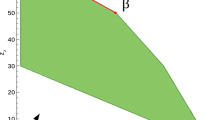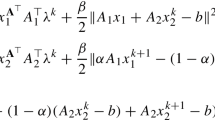Abstract
Minimizing the Lennard-Jones potential, the most-studied modelproblem for molecular conformation, is an unconstrained globaloptimization problem with a large number of local minima. In thispaper, the problem is reformulated as an equality constrainednonlinear programming problem with only linear constraints. Thisformulation allows the solution to approached through infeasibleconfigurations, increasing the basin of attraction of the globalsolution. In this way the likelihood of finding a global minimizeris increased. An algorithm for solving this nonlinear program isdiscussed, and results of numerical tests are presented.
Similar content being viewed by others
References
R.H. Byrd, E. Eskow, and R.B. Schnabel, "A new large-scale global optimization method and its application to Lennard-Jones problems," Technical Report CU-CS-630-92, University of Colorado at Boulder, Department of Computer Science, Boulder, CO 80309, 1992.
R.H. Byrd, E. Eskow, R.B. Schnabel, and S.L. Smith, "Parallel global optimization: Numerical methods, dynamic scheduling methods, and application to molecular conformation," in Parallel Computation, B. Ford and A. Fincham (Eds.), Oxford University Press, pp. 187–207, 1993.
T. Coleman, D. Shalloway, and Z. Wu, "Isotropic effective energy simulated annealing searches for low energy molecular cluster states," Journal of Computational Optimization and Applications, vol. 2, pp. 145–170, 1993.
T. Coleman and Z. Wu, "Parallel continuation-based global optimization for molecular conformation and protein folding," Technical Report MCS-P443-0694, Mathematics and Computer Science Division, Argonne National Laboratory, Argonne, IL, 1994.
G.M. Crippen and T.F. Havel, Distance Geometry and Molecular Conformation, John Wiley & Sons: New York, 1988.
J.E. Dennis and R.B. Schnabel, Numerical Methods for Unconstrained Optimization and Nonlinear Equations, Prentice-Hall: Englewood Cliffs, NJ, 1983.
A. Fiacco and G. McCormick, Nonlinear Programming: Sequential Unconstrained Minimization Techniques, John Wiley: New York, 1968.
M.S. Gockenbach, "An abstract analysis of differential semblance optimization," Ph.D. Thesis, Department of Computational and Applied Mathematics, Rice University, Houston, TX 77251.
M.S. Gockenbach, W.W. Symes, and R.A. Tapia, "Seismic velocity via regularization of a related problem," to appear in Inverse Problems.
M.R. Hoare, "Structure and dynamics of simple microclusters," Adv. Chem. Phys., vol. 40, pp. 49–135, 1979.
M.R. Hoare and P. Pal, "Physical cluster mechanics: Statics and energy surfaces for monatomic systems," Adv. Phys., vol. 20, pp. 161–196, 1971.
M.R. Hoare and J.A. McInnes, "Morphology and statistical statics of simple microclusters," Adv. Phys., vol. 32, pp. 791–821, 1983.
R.S. Judson, M.E. Colvin, J.C. Meza, A. Huffer, and D. Gutierrez, "Do intelligent configuration search techniques outperform random search for large molecules?," Sandia Report 91-8740, Sandia National Laboratories, Albuquerque, NM 87185, 1991.
J. Kostrowicki, L. Piela, B.J. Cherayil, and H.A. Scheraga, "Performance of the diffusion equation method in searches for optimum structures of Lennard-Jones atoms," J. Phys. Chem., vol. 95, pp. 4113–4119, 1991.
Z. Li and H.A. Scheraga, "Monte carlo minimization approach to the multiple-minima problem in protein folding," Proc. Natl. Acad. Sci. USA, 1987, vol. 84, pp. 6611–6615.
D.C. Liu and J. Nocedal, "On the limited memory BFGS method for large scale optimization," Math. Prog., vol. 45, pp. 503–528, 1989.
J. Nocedal, "Updating quasi-newton matrices with limited storage," Mathematics of Computation, vol. 35, pp. 773–782, 1980.
J.A. Northby, "Structure and binding of Lennard-Jones clusters: 13 ( n( 147," J. Chem. Phys., vol. 6, pp. 599–616, 1987.
L. Piela, J. Kostrowicki, and H.A. Scheraga, "The multiple-minima problem in the conformational analysis of molecules, deformation of the potential energy hypersurface by the diffusion equation method," J. Phys. Chem., vol. 93, pp. 3339–3346, 1989.
W.W. Symes, "Velocity inversion: A case study in infinite-dimensional optimization," Math. Prog., vol. 48, pp. 71–102, 1990.
L.T. Wille, "Minimum-energy configurations of atomic clusters: New results obtained by simulated annealing," Chem. Phys. Lett., vol. 133, pp. 405–410, 1987.
S.R. Wilson and W. Cui, "Applications of simulated annealing to peptides," Biopolymers, vol. 29, pp. 225–235, 1991.
Z. Wu, "The effective energy transformation scheme as a general continuation approach to global optimization with applications to molecular conformation," Technical Report CTC93TR143, Advanced Computing Research Institute, Cornell University, Ithaca, NY, 1992.
G.L. Xue, "Improvement on the Northby algorithm for molecular conformation: Better solutions," Pre-print 92-055, Army High Performance Computing Research Center, University of Minnesota, Minneapolis, 1992.
Author information
Authors and Affiliations
Rights and permissions
About this article
Cite this article
Gockenbach, M.S., Kearsley, A.J. & Symes, W.W. An Infeasible Point Method for Minimizing the Lennard-Jones Potential. Computational Optimization and Applications 8, 273–286 (1997). https://doi.org/10.1023/A:1008627606581
Issue Date:
DOI: https://doi.org/10.1023/A:1008627606581




